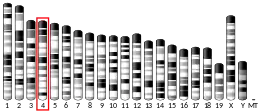HSPB7
Heat Shock Protein Family B (small) member 7 (HSPB7) in humans is a protein encoded by a gene of the same name with four exons that is located on chromosome 1p36.13.[4],.[5] HSPB7 contains 170 amino acids and has a molecular weight of 18,611Da.[6] HSPB7 is a member of human small heat shock protein (HSPB) family, which contains eleven family members of chaperone proteins.[7] HSPB7 and its gene pair SRARP are located 5 kb apart on the opposite strands of chromosome 1p36.13.[8]
| HSPB7 | |||||||||||||||||||||||||||||||||||||||||||||||||||
|---|---|---|---|---|---|---|---|---|---|---|---|---|---|---|---|---|---|---|---|---|---|---|---|---|---|---|---|---|---|---|---|---|---|---|---|---|---|---|---|---|---|---|---|---|---|---|---|---|---|---|---|
| Identifiers | |||||||||||||||||||||||||||||||||||||||||||||||||||
| Aliases | HSPB7, cvHSP, heat shock protein family B (small) member 7 | ||||||||||||||||||||||||||||||||||||||||||||||||||
| External IDs | OMIM: 610692 MGI: 1352494 HomoloGene: 8480 GeneCards: HSPB7 | ||||||||||||||||||||||||||||||||||||||||||||||||||
| |||||||||||||||||||||||||||||||||||||||||||||||||||
| |||||||||||||||||||||||||||||||||||||||||||||||||||
| |||||||||||||||||||||||||||||||||||||||||||||||||||
| Wikidata | |||||||||||||||||||||||||||||||||||||||||||||||||||
| |||||||||||||||||||||||||||||||||||||||||||||||||||
Expression and molecular function
HSPB7 is widely expressed throughout the body and its highest expression is observed in the cardiac tissue [7],.[9] HSPB protein family, including HSPB7, act protectively on aggregation of several proteins containing an extended polyglutamine (polyQ) stretch that are linked to a variety of neurodegenerative diseases.[10] Among these proteins, HSPB7 is the most potent polyQ aggregation suppressor within the HSPB family of chaperones.[10] In addition, HSPB7 protein contains a HSP20 domain and strongly interacts with the chaperone protein 14-3-3.[8] An interaction with the 14-3-3 protein is a common molecular feature between HSPB7 and SRARP proteins [8],[11]
Role in cardiomyopathy and Cancer
HSPB7 has cardiac protective functions and mutations in this gene leads to cardiomyopathies.[10] It has been suggested that HSPB7 cardioprotective function is mediated by facilitating sarcomeric proteostasis.[12] Furthermore, HSPB7 is widely inactivated in malignancies by copy-number loss and epigenetic silencing and the overexpression of this protein results in a tumor suppressor function in multiple cancer cell lines[8],.[13] The overexpression of HSPB7 and its gene pair SRARP lead to a reduction in the relative phosphorylation and/or expression of Akt and ERK in cancer cells.[8] In addition, it has been suggested that HSBP7 is regulated by p53 tumor suppressor in renal cell carcinoma.[13]
| Approved Symbol | HSPB7 |
|---|---|
| Approved Name | Heat shock protein family B (small) member 7 |
| HGNC ID | HGNC:5249 |
| Previous name | heat shock 27kD protein family, member 7 (cardiovascular) |
| Alias Symbols | cvHSP |
| Chromosome location | 1p36.13 |
| Ensembl | ENSG00000173641 |
| UniProt | Q9UBY9 |
| NCBI Gene | 27129 |
| RefSeq | NM_014424 |
| UCSC | uc001axo.2 |
| Protein Sequence | HSPB7 Protein Sequence (Ensembl) |
| Wikidata | Q18038659 |
| PubMed | HSPB7 PubMed References |
References
- GRCm38: Ensembl release 89: ENSMUSG00000006221 - Ensembl, May 2017
- "Human PubMed Reference:". National Center for Biotechnology Information, U.S. National Library of Medicine.
- "Mouse PubMed Reference:". National Center for Biotechnology Information, U.S. National Library of Medicine.
- "HSPB7". HUGO Gene Nomenclature Committee.
- "HSPB7 heat shock protein family B (small) member 7 [ Homo sapiens (human)]". The National Center for Biotechnology Information.
- "HSPB7_HUMAN". UniProt.
- Vos MJ, Kanon B, Kampinga HH (August 2009). "HSPB7 is a SC35 speckle resident small heat shock protein". Biochimica et Biophysica Acta (BBA) - Molecular Cell Research. 1793 (8): 1343–53. doi:10.1016/j.bbamcr.2009.05.005. PMID 19464326.
- Naderi A (May 2018). "SRARP and HSPB7 are epigenetically regulated gene pairs that function as tumor suppressors and predict clinical outcome in malignancies". Molecular Oncology. 12 (5): 724–755. doi:10.1002/1878-0261.12195. PMC 5928383. PMID 29577611.
- Wu T, Mu Y, Bogomolovas J, Fang X, Veevers J, Nowak RB, et al. (November 2017). "HSPB7 is indispensable for heart development by modulating actin filament assembly". Proceedings of the National Academy of Sciences of the United States of America. 114 (45): 11956–11961. Bibcode:2017PNAS..11411956W. doi:10.1073/pnas.1713763114. PMC 5692592. PMID 29078393.
- Vos MJ, Zijlstra MP, Kanon B, van Waarde-Verhagen MA, Brunt ER, Oosterveld-Hut HM, et al. (December 2010). "HSPB7 is the most potent polyQ aggregation suppressor within the HSPB family of molecular chaperones". Human Molecular Genetics. 19 (23): 4677–93. doi:10.1093/hmg/ddq398. PMID 20843828.
- Naderi A (August 2017). "C1orf64 is a novel androgen receptor target gene and coregulator that interacts with 14-3-3 protein in breast cancer". Oncotarget. 8 (34): 57907–57933. doi:10.18632/oncotarget.17826. PMC 5593696. PMID 28915724.
- Mercer EJ, Lin YF, Cohen-Gould L, Evans T (March 2018). "Hspb7 is a cardioprotective chaperone facilitating sarcomeric proteostasis". Developmental Biology. 435 (1): 41–55. doi:10.1016/j.ydbio.2018.01.005. PMC 5818303. PMID 29331499.
- Lin J, Deng Z, Tanikawa C, Shuin T, Miki T, Matsuda K, Nakamura Y (May 2014). "Downregulation of the tumor suppressor HSPB7, involved in the p53 pathway, in renal cell carcinoma by hypermethylation". International Journal of Oncology. 44 (5): 1490–8. doi:10.3892/ijo.2014.2314. PMC 4027944. PMID 24585183.

